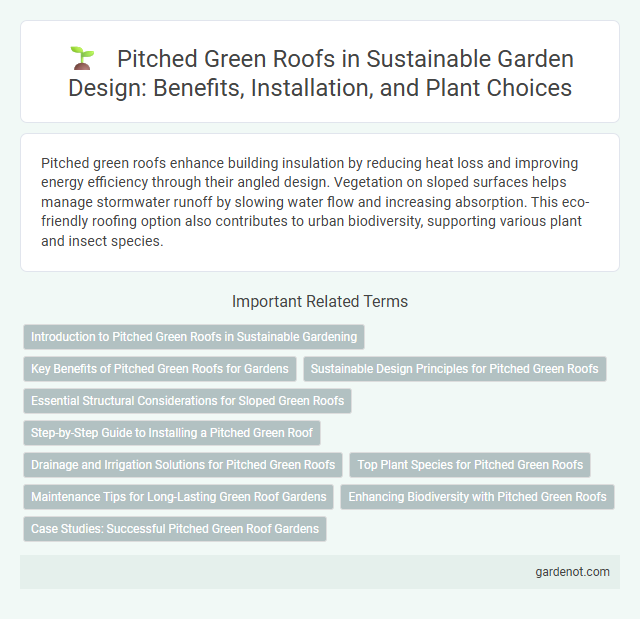Pitched green roofs enhance building insulation by reducing heat loss and improving energy efficiency through their angled design. Vegetation on sloped surfaces helps manage stormwater runoff by slowing water flow and increasing absorption. This eco-friendly roofing option also contributes to urban biodiversity, supporting various plant and insect species.
Introduction to Pitched Green Roofs in Sustainable Gardening
Pitched green roofs are sloped roofing systems designed to support vegetation, enhancing biodiversity and improving water management in sustainable gardening. These roofs utilize specialized growing mediums and drainage layers to retain plants on angled surfaces, promoting natural insulation and reducing urban heat island effects. Their integration into eco-friendly landscapes helps lower energy consumption and supports stormwater runoff control, making them essential components of green infrastructure.
Key Benefits of Pitched Green Roofs for Gardens
Pitched green roofs enhance garden spaces by improving water drainage and reducing runoff, preventing erosion and promoting healthier plant growth. Their angled design maximizes sun exposure, encouraging diverse plant species to thrive while providing natural insulation that regulates indoor temperatures. These roofs contribute to urban biodiversity, support local wildlife habitats, and increase property value through sustainable landscaping solutions.
Sustainable Design Principles for Pitched Green Roofs
Pitched green roofs enhance sustainable design principles by improving stormwater management through increased runoff retention and reducing urban heat island effects with vegetation layers. These roofs utilize lightweight substrates and drought-resistant plants to minimize structural load and water consumption, promoting environmental resilience. Incorporating native plant species and proper drainage systems ensures biodiversity support and long-term roof durability in pitched green roof installations.
Essential Structural Considerations for Sloped Green Roofs
Pitched green roofs require robust waterproofing layers and effective root barriers to prevent damage and ensure longevity on slopes between 15 and 45 degrees. Structural support must account for the additional weight of saturated growing media and vegetation, necessitating reinforced framing and appropriate load distribution. Drainage systems designed for efficient water runoff are critical to avoid erosion and maintain plant health on sloped surfaces.
Step-by-Step Guide to Installing a Pitched Green Roof
Installing a pitched green roof starts with ensuring a structurally sound base and waterproof membrane to prevent leaks and support vegetation weight. Next, an appropriate drainage layer and root barrier are installed to maintain moisture balance and protect the roof structure. Finally, a lightweight growing medium is spread evenly, followed by planting drought-resistant, low-maintenance vegetation ideal for sloped surfaces.
Drainage and Irrigation Solutions for Pitched Green Roofs
Efficient drainage systems are essential for pitched green roofs to prevent waterlogging and ensure proper runoff, often utilizing layered substrates and integrated drainage mats to channel excess water effectively. Irrigation solutions for pitched green roofs typically include drip irrigation or automated sprinklers calibrated to maintain optimal moisture levels, compensating for rapid water loss on sloped surfaces. Combining these drainage and irrigation techniques enhances plant health, reduces erosion risk, and promotes sustainable green roof performance.
Top Plant Species for Pitched Green Roofs
Sedum species, such as Sedum album and Sedum spurium, dominate pitched green roofs due to their drought tolerance and shallow root systems, which prevent soil erosion on slopes. Native grasses like Festuca rubra and Carex flacca also contribute to slope stabilization while enhancing biodiversity on pitched green roofs. These top plant species ensure optimal water retention, reduce runoff, and promote microclimate regulation in urban environments.
Maintenance Tips for Long-Lasting Green Roof Gardens
Regular inspection of pitched green roofs is essential to identify issues like erosion, plant stress, or drainage blockages early, ensuring long-lasting health. Maintaining proper irrigation balanced to slope conditions prevents water runoff and supports vegetation growth. Removing invasive plants and debris promotes root stability and overall system durability on sloped green roof gardens.
Enhancing Biodiversity with Pitched Green Roofs
Pitched green roofs create diverse habitats by supporting a variety of plant species adapted to sloped environments, which increases local biodiversity. Their layered soil structure and microclimates offer shelter and resources for pollinators, birds, and insects, fostering urban ecological networks. These roofs contribute to ecological resilience by enhancing habitat connectivity in densely built areas.
Case Studies: Successful Pitched Green Roof Gardens
Case studies of successful pitched green roof gardens demonstrate enhanced stormwater management and increased thermal insulation in urban environments. Projects like the Chicago City Hall and the Vancouver Convention Centre showcase how sloped green roofs can support diverse vegetation while maintaining structural integrity. These installations highlight the benefits of maximizing green space on angled surfaces for biodiversity and energy efficiency.
Pitched green roof Infographic

 gardenot.com
gardenot.com